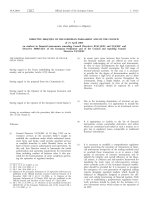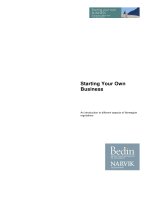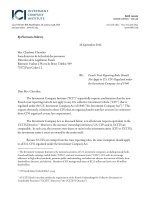The Many Different Kinds of Debt ppsx
Bạn đang xem bản rút gọn của tài liệu. Xem và tải ngay bản đầy đủ của tài liệu tại đây (84.74 KB, 6 trang )
CHAPTER 25
The Many Different Kinds of Debt
Answers to Practice Questions
1. If the bond is issued at face value and investors demand a yield of 9.5%, then,
immediately after the issue, the price will be $1,000. As time passes, the price
will gradually rise to reflect accrued interest. For example, just before the first
(semi-annual) coupon payment, the price will be $1,047.50, and then, upon
payment of the coupon ($47.50), the price will drop to $1,000. This pattern will
be repeated throughout the life of the bond as long as investors continue to
demand a return of 9.5%.
2. Answers here will vary, depending on the company chosen. Some key areas
that should be examined are: coupon rate, maturity, security, sinking fund
provision, and call provision.
3. Floating-rate bonds provide bondholders with protection against inflation and
rising interest rates, but this protection is not complete. In practice, the extent of
the protection depends on the frequency of the rate adjustments and the
benchmark rate. (Not only can the yield curve shift, but yield spreads can shift as
well.)
Similarly, puttable bonds provide the bondholders with protection against an
increase in default risk, but this protection is not absolute. If the company’s
problems suddenly become public knowledge, the value of the company may fall
so quickly that bondholders might still suffer losses even if they put their bonds
immediately.
4. First mortgage bondholders will receive the $200 million proceeds from the sale
of the fixed assets. The remaining $50 million of mortgage bonds then rank
alongside the unsecured senior debentures. The remaining $100 million in
assets will be divided between the mortgage bondholders and the senior
debenture holders. Thus, the mortgage bondholders are paid in full, the senior
debenture holders receive $50 million and the subordinated debenture holders
receive nothing.
234
5. If the assets are sold and distributed according to strict precedence, the following
distribution will result. In Subsidiary A, the $320 million of debentures will be paid
off and ($500 million - $320 million) = $180 million will be remitted to the parent.
In Subsidiary B, the $180 million of senior debentures will be paid off and
($220 million - $180 million) = $40 million of the $60 million subordinated
debentures will be paid. In the holding company, the real estate will be sold and
($180 million + $80 million) = $260 million will be paid in partial satisfaction of the
$400 million senior collateral trust bonds.
6. a. Typically, a variable-rate mortgage has a lower interest rate than a
comparable fixed-rate mortgage. Thus, you can buy a bigger house for
the same mortgage payment if you use a variable-rate mortgage. The
second consideration is risk. With a variable-rate mortgage, the borrower
assumes the interest rate risk (although in practice this is mitigated
somewhat by the use of caps), whereas, with a fixed-rate mortgage, the
lending institution assumes the risk.
b. If borrowers have an option to prepay on a fixed-rate mortgage, they are
likely to do so when interest rates are low. Of course, this is not the time
that lenders want to be repaid because they do not want to reinvest at the
lower rates. On the other hand, the option to prepay has little value if
rates are floating, so floating rate mortgages reduce the reinvestment risk
for holders of mortgage pass-through certificates.
7. A sharp increase in interest rates reduces the price of an outstanding bond
relative to the price of a newly issued bond. For a given call price, this implies
that the value to the firm of the call provision is greater for the newly issued bond.
Other things equal, the yield of the more recently issued bonds should be
greater, reflecting the higher probability of call. Notice, however, that the
outstanding bond will probably have a lower call price and perhaps a shorter
period of call protection; these may be offsetting factors.
8. If the company acts rationally, it will call a bond as soon as the bond price
reaches the call price. For a zero-coupon bond, this will never happen because
the price will always be below the face value. For the coupon bond, there is
some probability that the bond will be called. To put this somewhat differently,
the company’s option to call is meaningless for the zero-coupon bond, but has
some value for the coupon bond. Therefore, the price of the coupon bond (all
else equal) will be less than the price of the zero, and, hence, the yield on the
coupon bond will be higher.
235
9. a. Using Figure 25.2 in the text, we can see that, if interest rates rise, the
change in the price of the noncallable bond will be greater than the
change in price of the callable bond.
b. On that date, it will be in one party’s interest to exercise its option, and the
bonds will be repaid.
10. See figure below.
11. Most bonds contain covenants that restrict the firm’s ability to issue new debt of
equal or greater seniority unless the firm’s tangible assets exceed some multiple
of the existing debt. This restriction is intended to preclude the firm from
increasing the default risk borne by existing bondholders.
A similar restriction is the negative pledge clause, which prevents the firm from
issuing more secured debt. Even if this did not increase the ratio of debt to
tangible assets, it would decrease the value of unsecured debt because
unsecured debt is junior to secured debt in the event of default.
12. The issue of additional junior debt does not harm the senior bondholders. As far
as senior bondholders are concerned, the junior debt is similar to equity. The
senior bondholders would prefer that the junior debt not have a shorter maturity,
but it is still in their interest to have a claim on the money put up by the junior
bondholders for the duration of the junior debt.
13. Alpha Corp.’s net tangible asset limit is 200 percent of senior debt. Therefore,
with net tangible assets of $250 million, Alpha’s total debt cannot exceed
$125 million. Alpha can issue an additional $25 million in senior debt.
236
Value of
straight bond
Value of puttable bond
0
100
100
Putttable bond
Straight bond
14. a. There are two primary reasons for limitations on the sale of company
assets. First, coupon and sinking fund payments provide a regular check
on the company’s solvency. If the firm does not have the cash, the
bondholders would like the shareholders to put up new money or default.
But this check has little value if the firm can sell assets to pay the coupon
or sinking fund contribution. Second, the sale of assets in order to
reinvest in more risky ventures harms the bondholders.
b. The payment of dividends to shareholders reduces assets that can be
used to pay off debt. In the extreme case, a dividend that is equal to the
value of the assets leaves bondholders with nothing.
c. If the existing debt is junior, then the original debtholders lose by having
the new debt rank ahead of theirs. If the existing debt is senior, then debt
the issuance of additional senior debt means that the same amount of
equity supports a greater amount of debt; i.e., the firm’s leverage has
increased, and the firm faces a greater probability of default. This harms
the original debtholders.
15. Answers will vary depending on instrument chosen.
16. For purposes of illustration, assume the Christiania Bank issue is a one-year
reverse floater. Suppose also that the current interest rate on fixed-rate one-year
loans is 7.8 percent. Then, for three different possible future interest rates, the
payoffs on the reverse floater, a fixed-rate loan, and a normal floating-rate loan
are as follows:
Possible Future
Interest Rates
Payoffs at End of Year
Reverse Floater Fixed-Rate Normal Floater
9.8% 1,030 1,078 1,098
7.8% 1,050 1,078 1,078
5.8% 1,070 1,078 1,058
Now consider the payoffs if you borrowed $1,000 at a floating rate and loaned
$1,974 at a fixed rate of 7.8%:
Possible Future
Interest Rates
Payoffs at End of Year
Floating Rate
Borrowing
Fixed-Rate
Lending
Total
9.8% -1,098 2,128 1,030
7.8% -1,078 2,128 1,050
5.8% -1,058 2,128 1,070
Thus, buying a reverse floater is equivalent to issuing floating-rate debt and
buying fixed-rate debt. This is equivalent to borrowing at short-term rates in
order to lend long-term, which is a risky strategy. The reverse floater is a very
volatile bet on future interest rates.
237
17. Project finance makes sense if the project is physically isolated from the parent,
offers the lender tangible security and involves risks that are better shared
between the parent and others. The best example is in the financing of major
foreign projects, where political risk can often be minimized by involving
international lenders.
18. A prepackaged bankruptcy avoids the expenses of a bankruptcy court, and can
usually be negotiated more quickly. A prepackaged bankruptcy also avoids the
problems that can arise, as in Eastern’s case, from continuing to operate assets
at a loss. Unlike informal workouts, prepackaged bankruptcies reduce the
likelihood of subsequent litigation and get the tax advantages of Chapter 11. The
problems of conflicts of interest are the same, and each party can threaten to
hold out for a court solution unless the respective parties each believe that the
prepackaged bankruptcy provides at least as good a deal.
238
Challenge Questions
1. The existing bonds provide $30,000 per year for 10 years and a payment of
$1,000,000 in the tenth year. Assuming that all bondholders are exempt from
income taxes, the market value of the bonds is:
$569,880
1.10
1,000,000
1.10
30,000
1.10
30,000
1.10
30,000
PV
10102
=++++=
Thus, the debt could be repurchased with a payment of $569,880 today.
From the standpoint of the company, the cash outflows associated with the
bonds are $1,000,000 in the tenth year, and $30,000 per year, less annual tax
savings of (0.35 × $30,000) = $10,500. Therefore, the net cash outflow is
($30,000 - $10,500) = $19,500 per year. To calculate the amount of new 10
percent debt supported by these cash flows, discount the after-tax cash flows at
the after-tax interest rate (6.5 percent):
$672,908
1.065
1,000,000
1.065
19,500
1.065
19,500
1.065
19,500
PV
10102
=++++=
In other words, the value of these bonds to the firm is $672,908 and the market
value of the bonds is $569,880. The firm could repurchase the bonds for
$569,880 and then issue $672,908 of new 10 percent debt that would require
cash outflows with a present value equal to that of the original debt. The firm
could also, of course, immediately pocket the difference ($103,028).
Now suppose that bondholders are subject to personal income taxes. High-
income investors (i.e., those in high income tax brackets) will favor low-coupon
bonds and will bid up the prices of those bonds. If the low coupon bonds are
worth more to the high-income investor than they are to Dorlcote, then Dorlcote
should not repurchase the bonds. (Note that, if Dorlcote issued the 3 percent
bonds at face value and then repurchases the bonds for $569,880, then the
company will be liable for taxes on the gain.)
2. The advantages of setting up a separately financed company for Hubco stem
primarily from the attempt to align the interests of various parties with the
successful operation of the plant. For example, the construction firm was also a
shareholder in order to ensure that the plant would run according to
specifications. By making it a separate entity, Hubco could also enter into
contraction agreements without the need to gain approval from a parent
company. Similarly, if Hubco failed, then no assets beyond the projects’ could be
attached. Independence also allowed Hubco to design contracts with suppliers,
customers, and funding sources to meet specific needs and/or concerns.
239









